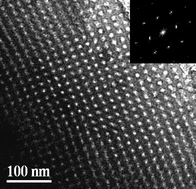Thick wall mesoporous carbons with a large pore structure templated from a weakly hydrophobic PEO–PMMA diblock copolymer†
Abstract
Thick wall mesoporous carbons (FDU-18) with ordered large pore structures were synthesized via an evaporation induced self-assembly (![[3 with combining macron]](https://www.rsc.org/images/entities/char_0033_0304.gif) m) with a large unit cell (∼38 nm).
m) with a large unit cell (∼38 nm).


 Please wait while we load your content...
Please wait while we load your content...